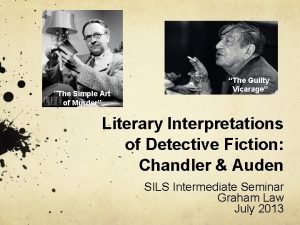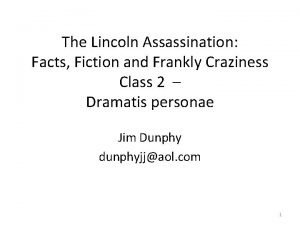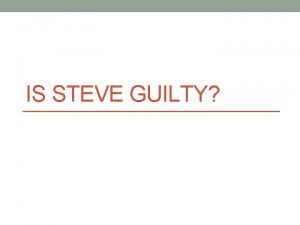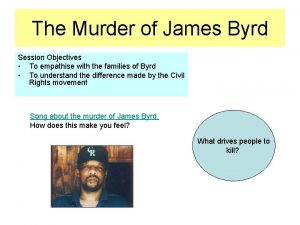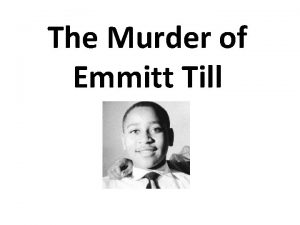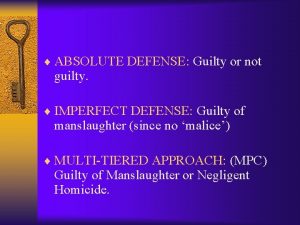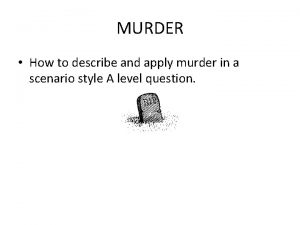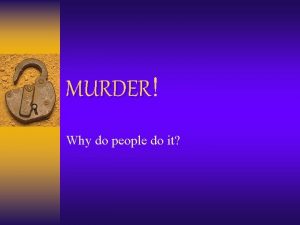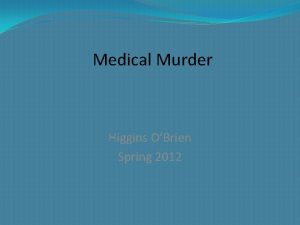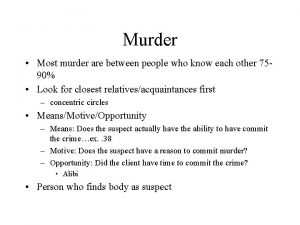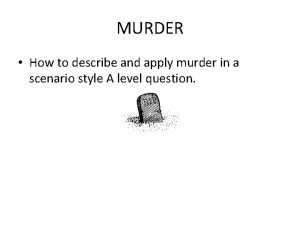The Simple Art of Murder The Guilty Vicarage






![Chandler’s ideas (2) [Dashiell] Hammett wrote … for people with a sharp, aggressive attitude Chandler’s ideas (2) [Dashiell] Hammett wrote … for people with a sharp, aggressive attitude](https://slidetodoc.com/presentation_image_h/dd9b39c60d0896e59aa48dc4bff622aa/image-7.jpg)





- Slides: 12

”The Simple Art of Murder” “The Guilty Vicarage” Literary Interpretations of Detective Fiction: Chandler & Auden SILS Intermediate Seminar Graham Law July 2013

Some general approaches psychological - Freud: primal scene, Oedipus complex, etc materialist - Marx: social alienation, cultural commodification post-modern - Foucault: state surveillance, regimentation, discipline

Raymond Chandler (1888 -1959) Wystan Hugh Auden (1907 -1973) US >> UK >> US novelist & screenwriter poet & playwright hardboiled fiction Marxist >> Catholic depression & alcoholism gay Chandler & Auden

Chandler’s style It was about eleven o’clock in the morning, mid October, with the sun not shining and a look of hard wet rain in the clearness of the foothills. I was wearing my powder-blue suit, with dark blue shirt, tie and display handkerchief, black brogues, black wool socks with dark blue clocks on them. I was neat, clean, shaved and sober, and I didn't care who knew it. I was everything the well-dressed private detective ought to be. I was calling on four million dollars. The main hallway of the Sternwood place was two stories high. Over the entrance doors, which would have let in a troop of Indian elephants, there was a broad stained-glass panel showing a knight in dark armor rescuing a lady who was tied to a tree and didn't have any clothes on but some very long and convenient hair. The knight had pushed the vizor of his helmet back to be sociable, and he was fiddling with the knots on the ropes that tied the lady to the tree and not getting anywhere. I stood there and thought that if I lived in the house, I would sooner or later have to climb up there and help him. He didn't seem to be really trying. Opening of The Big Sleep (1939)

Chandler on detective fiction “The Simple Art of Murder”, essay first published in the Atlantic Monthly (Dec. 1944), revised version in short story collection, The Simple Art of Murder (1950)

Chandler’s ideas (1) I suppose the principal dilemma of the traditional or classic or straight-deductive or logic-and-deduction novel of detection is that for any approach to perfection it demands a combination of qualities not found in the same mind. … The grim logician has as much atmosphere as a drawing-board. The scientific sleuth has a nice new shiny laboratory, but I'm sorry I can't remember the face. The classic detective story, has learned nothing and forgotten nothing. … fundamentally it is the same careful grouping of suspects, the same utterly incomprehensible trick of how some body stabbed Mrs Pottington Postlethwaite with the solid platinum poniard just as she flatted on the top note of the Bell Song from Lame in the presence of fifteen ill-assorted guests. There is a very simple statement to be made about all these stories: they do not really come off intellectually as problems, and they do not come off artistically as fiction. They are too contrived, and too little aware of what goes on in the world. They try to be honest, but honesty is an art.
![Chandlers ideas 2 Dashiell Hammett wrote for people with a sharp aggressive attitude Chandler’s ideas (2) [Dashiell] Hammett wrote … for people with a sharp, aggressive attitude](https://slidetodoc.com/presentation_image_h/dd9b39c60d0896e59aa48dc4bff622aa/image-7.jpg)
Chandler’s ideas (2) [Dashiell] Hammett wrote … for people with a sharp, aggressive attitude to life. They were not afraid of the seamy side of things; they lived there. Violence did not dismay them; it was right down their street. Hammett gave murder back to the kind of people that commit it for reasons, not just to provide a corpse; and with the means at hand, not with handwrought duelling pistols, curare, and tropical fish. He put these people down on paper as they are, and he made them talk and think in the language they customarily used for these purposes. In everything that can be called art there is a quality of redemption. it may be pure tragedy, if it is high tragedy, and it may be pity and irony, and it may be the raucous laughter of the strong man. But down these mean streets a man must go who is not himself mean, who is neither tarnished nor afraid. The detective in this kind of story must be such a man. He is the hero, he is everything. The story is this man's adventure in search of a hidden truth, and it would be no adventure if it did not happen to a man fit for adventure. He has a range of awareness that startles you, but it belongs to him by right, because it belongs to the world he lives m. If there were enough like him, I think the world would be a very safe place to live in, and yet not too dull worth living in.

Auden’s style “Funeral Blues” (1936) Stop all the clocks, cut off the telephone. Prevent the dog from barking with a juicy bone, Silence the pianos and with muffled drum Bring out the coffin, let the mourners come. Let aeroplanes circle moaning overhead Scribbling in the sky the message He is Dead, Put crêpe bows round the white necks of the public doves, Let the traffic policemen wear black cotton gloves. He was my North, my South, my East and West, My working week and my Sunday rest My noon, my midnight, my talk, my song; I thought that love would last forever, I was wrong. The stars are not wanted now; put out every one, Pack up the moon and dismantle the sun. Pour away the ocean and sweep up the woods; For nothing now can ever come to any good. (Recited in movie Four Weddings & a Funeral, 1994)

Auden on detective fiction “The Guilty Vicarage”, essay first published in Harper’s Magazine (May 1948), Reprinted in essay collection, The Dyer’s Hand (1963)

Auden’s ideas (1) For me, as for many others, the reading of detective stories is an addiction like tobacco or alcohol. The symptoms of this are: Firstly, the intensity of the craving — if I have any work to do, I must be careful not to get hold of a detective story for, once I begin one, I cannot work or sleep till I have finished it. Secondly, its specificity — the story must conform to certain formulas (I find it very difficult, for example, to read one that is not set in rural England). And, thirdly, its immediacy. I forget the story as soon as I have finished it, and have no wish to read it again. If, as sometimes happens, I start reading one and find after a few pages that I have read it before, I cannot go on. … Such reactions convince me that … detective stories have nothing to do with works of art. The vulgar definition, “a Whodunit, ” is correct. The basic formula is this: a murder occurs; many are suspected; all but one suspect, who is the murderer, are eliminated; the murderer is arrested or dies. … The interest in the detective story is the dialectic of innocence and guilt.

Auden’s ideas (2) Mr. Raymond Chandler has written that he intends to take the body out of the vicarage garden and give murder back to those who are good at it. If he wishes to write detective stories … he could not be more mistaken … Actually, whatever he may say, I think Mr. Chandler is interested in writing, not detective stories, but serious studies of a criminal milieu, the Great Wrong Place, and his powerful but extremely depressing books should be read and judged, not as escape literature, but as works of art. The magic formula [of the detective story] is an innocence which is discovered to contain guilt; then a suspicion of being the guilty one; and finally a real innocence from which the guilty other has been expelled, a cure effected, not by me or my neighbors, but by the miraculous intervention of a genius from outside. The phantasy, then, which the detective story addict indulges is the phantasy of being restored to the Garden of Eden, to a state of innocence, where he may know love as love and not as the law. The driving force behind this daydream is the feeling of guilt, the cause of which is unknown to the dreamer. The phantasy of escape is the same, whether one explains the guilt in Christian, Freudian, or any other terms.

The End SILS Intermediate Seminar Graham Law July 2013
 The simple art of murder
The simple art of murder Was willie jett guilty
Was willie jett guilty Remembrance emily bronte analysis
Remembrance emily bronte analysis Appearance vs reality macbeth context
Appearance vs reality macbeth context Counterclaim sentence starters
Counterclaim sentence starters Is steve harmon guilty
Is steve harmon guilty All are guilty before god
All are guilty before god No power of hell no scheme of man verse
No power of hell no scheme of man verse The raven text
The raven text Michigan murders
Michigan murders Donald byrd murder
Donald byrd murder The murder of emmitt till date
The murder of emmitt till date Carol lynn benson miss florida
Carol lynn benson miss florida
